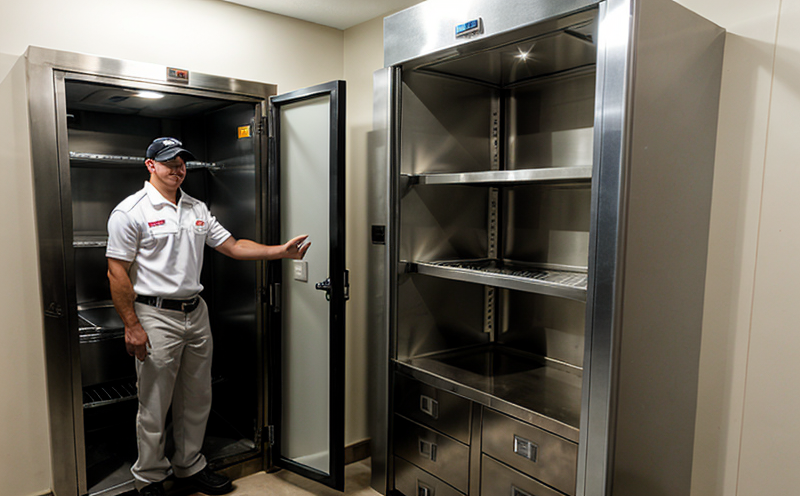Dumbwaiter inspection
The inspection of dumbwaiters is a crucial aspect in ensuring safety and compliance with international standards. Dumbwaiters are used to transport small loads, such as food or mail, between floors within buildings. Given their specific purpose and the nature of the goods they carry, it's imperative that these devices undergo thorough inspections.
These inspections typically involve a series of checks aimed at identifying potential safety hazards before they become critical issues. The inspection process is governed by various standards including ISO 21743:2018 and EN 81-20 for passenger elevators, which are also applicable to dumbwaiters.
The primary goal of a dumbwaiter inspection is to ensure that the device operates within safe parameters. This involves evaluating critical components such as hoisting ropes, pulleys, guides, sheaves, and governors. The integrity of these parts ensures smooth operation while minimizing the risk of accidents or malfunctions.
During an inspection, technicians will check for signs of wear and tear on the moving parts, inspect the electrical systems to ensure they are functioning correctly, and verify that all safety mechanisms are operational. Any deviations from the specified tolerances are noted, and appropriate corrective actions are recommended.
The findings of these inspections are documented in a detailed report. This document serves as a comprehensive record of the inspection process and provides insights into any areas requiring immediate attention or routine maintenance. Regular inspections help in extending the service life of dumbwaiters by catching potential issues early on, thereby reducing downtime and operational costs.
Quality managers and compliance officers play a pivotal role in ensuring that all testing and inspections are conducted according to industry standards. By integrating regular inspections into their maintenance schedules, they can maintain high levels of safety and reliability for their facilities. R&D engineers benefit from such inspections as it provides them with real-world data which can be used to improve designs and functionalities.
Scope and Methodology
| Component Inspection | Method of Evaluation |
|---|---|
| Hoisting ropes | Audible and visual checks for signs of wear, fraying, or damage. |
| Pulleys and guides | In-depth examination using specialized tools to assess alignment and smoothness. |
| Safety devices (governors) | Functional testing under simulated conditions to verify proper operation. |
| Electrical systems | Voltage checks and insulation resistance tests to ensure safe operation. |
The inspection process is meticulous, requiring the use of various tools and techniques to ensure no detail is overlooked. Technicians must be well-versed in the specific standards applicable to dumbwaiters, such as ISO 21743:2018, which provides comprehensive guidelines for this type of equipment.
Following each inspection, a detailed report is generated, listing all findings and recommendations. This report serves not only as a record but also as a valuable tool for future maintenance planning. It helps in prioritizing areas that require immediate attention or routine checks to ensure the continued safe operation of dumbwaiters.
Industry Applications
| Application Area | Description |
|---|---|
| Hospital and Healthcare Facilities | Dumbwaiters are used to transport medical supplies, patient meals, and other essential items between floors. |
| Residential Buildings | In multi-story residential complexes, dumbwaiters provide a convenient way for residents to move small loads without the need for stairs. |
| Commercial Office Spaces | Dumbwaiters are utilized in office buildings to transport documents and other materials efficiently within the building. |
| Catering Services | In hotels and restaurants, dumbwaiters facilitate the rapid delivery of food and beverages between floors. |
Given their versatility and safety features, dumbwaiters find applications across various sectors. They are particularly useful in environments where quick, safe transport is paramount. Regular inspections play a crucial role in maintaining these devices' integrity, ensuring they continue to serve their intended purpose efficiently.
Quality and Reliability Assurance
The quality and reliability of dumbwaiters are paramount for safety and operational efficiency. Ensuring that these devices meet the required standards is essential in preventing accidents and maintaining compliance with international regulations.
A key aspect of quality assurance involves adhering strictly to inspection protocols as outlined in ISO 21743:2018. This includes not only the mechanical components but also the electrical systems which are integral to their operation. By following these guidelines, inspectors can identify potential issues before they escalate into critical problems.
The use of advanced diagnostic tools and techniques allows for more precise assessments, ensuring that even minute deviations from specifications are detected. This proactive approach to maintenance helps in extending the lifespan of dumbwaiters while minimizing operational disruptions.
Regular inspections also contribute significantly to reliability by identifying areas requiring routine maintenance or replacement. By addressing these issues early on, potential failures can be avoided, leading to smoother operations and reduced downtime. This not only enhances safety but also contributes positively to overall productivity within the facility.





